Advanced Electronics: Imagination Is Reality
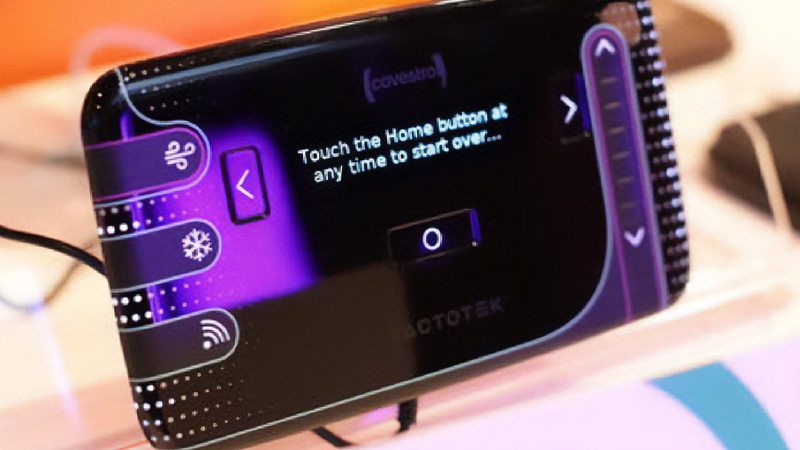
New molded and flexible electronics combine performance and design in new product types
Molded and formed electronics are taking cars, homes and even industrial workspaces into new realms of functionality by combining high-end electronics with sleek aesthetics.
The slim, highly contoured, in-mold structural electronic (IMSE) demonstrators developed by TactoTek of Finland (U.S. office is in Bloomfield Hills, Mich.), for example, are inspiring product designers to reimagine functional yet aesthetic surfaces in a variety of end uses.
Meanwhile, D&M Plastics of Burlington, Ill., and MTD Micro Molding of Charlton, Mass., tackle the production of molded electronics across the size spectrum with their expertise in extreme precision and tight production tolerances.
Then there’s FlexEnable of Cambridge, England, which specializes in flexible electronics that can be shaped to fit various part curvatures and geometries.
Taken together, the technologies of these specialists (and others) promise an unprecedented combination of form and function in electronics applications.
Smart and Sleek
The collaboration of TactoTek and resin supplier Covestro of Pittsburgh in shaping the former’s latest IMSE demonstrator device, Nighthawk, is testament to a long-running partnership that is bearing fruit for next-generation electronic products. Making its debut at the 2022 Consumer Electronics Show in Las Vegas in January, Nighthawk is a smart surfaces device that combines Covestro’s materials expertise with TactoTek’s skill in combining the science and art of structural electronics.
TactoTek’s core technology turns plastics into smart surfaces. The most common construction is a sandwich of a decorative film surface, molded resin, and printed and surface-mounted electronics on a bottom film that are integrated into a single seamless structure during injection molding. Nighthawk achieves its performance and aesthetics with Covestro’s Makrolon polycarbonate resin and Makrofol polycarbonate films.
Covestro formulates Makrolon to exhibit glass-like transparency and high impact resistance even at low temperatures. The resin also features high dimensional stability and is easily moldable, with high heat resistance and a glass transition temperature of 148°C (298°F). Makrofol films also achieve high heat resistance and transparency, along with toughness and elasticity over a wide temperature range while providing stiffness, electrical insulation properties, and resistance to abrasion and weathering.
The Nighthawk demonstrator presented at CES took the form of a high-tech thermostat controller, featuring sleek contours and stylish lighting and, importantly, features engaged by merely touching the smart surface. By eliminating bulky controls and electronics, this technology saves material by packing an extraordinary amount of electronic functionality in a slim space, opening a world of design options for brand owners.
“An IMSE part typically uses 50 to 75 percent less plastics relative to a conventional electronics part because all those controls and illumination features are delivered within a part that is the same thickness as just the cosmetic surface on a conventional electronics assembly,” says Dave Rice, senior vice president of marketing business development at TactoTek. “That means there are fewer parts to design, manufacture, source, tool, produce and assemble. These are all accelerants in today’s marketplace and are important contributors to improved sustainability.”
In the Nighthawk demonstrator presented as a thermostat controller, Makrofol was used for the “A” film, which is the cosmetic surface, and the “B” film, the electronics surface and carrier for the electronics that includes circuitry, touch controls and LEDs for icon illumination, as well as decorative illumination in patterned areas.
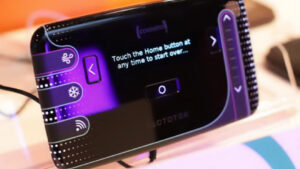
The Nighthawk demonstrator, a smart surfaces collaboration between TactoTek
and Covestro, is a slim, multilayer structure with contoured surface and in-mold structural electronics. Courtesy of Covestro
Looking at the front of the demonstrator, there are:
- Indicators on the left side to display operating mode.
- Arrows to the left and right of the screen that switch between modes.
- An on-off button in the center that also serves as a selector button.
- A textured slider with up and down arrows on the right side.
- A combination of gloss and matte black on the surface.
“In-mold structural electronic devices give product designers and engineers a sense of what can be achieved with control surfaces in homes, automobiles and industrial workspaces,” says Rice.
“Both the films and the resins are key elements of the IMSE structure. The top film in Nighthawk is used for both decoration and protection; the B film is the electronics carrier; and the resin provides structural integrity and encapsulates the printed and surface mounted electronics,” he explains. “Because we’re using the structure of the part itself to transmit light within the part, the optical properties of the resin are key to lighting performance.”
Initially, the influence of IMSE has been felt most in the automotive industry. “That demand continues to build,” Rice notes. “Accelerating even faster is demand for consumer, industrial and smart-home types of use cases. That led Covestro and TactoTek to develop a demonstrator that integrates an OLED (organic light-emitting diode) display, is controlled with in-molded touch controls, and has engaging and appealing ambient illumination features.”
Within the next year, Rice says, “there will be significant quantities of IMSE parts in consumer/industrial products on the market. A lot of these products will be introduced in North America.
Nighthawk was not the only new IMSE design introduced by TactoTek at CES—the Mesa controller was also on display for the first time at a public event. “We have some prominent designers in the automotive OEM space who are excited by the Mesa controller,” Rice remarks. “Interestingly, I got the same type of reaction from some home appliance manufacturers [at CES]. It shows that inspired user experience design can span markets and ultimately consumers will benefit with greater ease of use.”
He continues: “At this stage of technology deployment, we are seeing interest across the board. A lot of design leaders are gravitating toward these solutions because it gives them new tools in their palette. For instance, since we don’t have a flat rigid printed circuit board that is a required part of this construction, we can shape the part into conforming geometries, whether it’s the face of an elegant countertop appliance or the door spear (armrest component) in a vehicle.”
Precision Is Paramount
As electronics devices become more complex and components smaller, holding increasingly tighter tolerances in molding these sensitive parts requires formidable expertise.
In its nearly 50-year history, D&M Plastics has continually embraced the latest equipment to provide the dimensional accuracy that these parts and their customers require.
“Customers want tighter and tighter tolerances, which challenges repeatability and control over plastics processing parameters,” says Chip Owen, chief executive officer. “The increased use of electric presses has helped to mitigate this issue.” D&M Plastics has recently purchased Sodick and Toyo injection machines.
Besides the right equipment, the right know-how is essential, Owen adds. “Customers often lack knowledge in plastics. They come to us seeking our expertise in both part and tool design as well as material selection in order to achieve their product application requirements.
“Customers also approach us to help them in reducing part costs which we achieve through part design, tool design and process optimization. Focusing on these areas helps to optimize the amount of material in the part and cycle times, which reduce part costs.”
D&M is often called upon to process exotic materials, sometimes at tolerances tighter than 0.002 inch, Owen notes. Such materials might include biodegradable hemp- and corn-based plastics. “These are currently challenging to process, difficult to hold precise tolerances and limited in color selections. Many of the parts we produce are components of larger automated assemblies that require high precision.”
Reducing error rates is vital to success in molded electronics, says Martin Tremonti, chief operating officer. For instance, D&M produced a relay housing for Omron Global that previously failed under extremely cold temperatures. Omron facilitated development of a special liquid crystal polymer (LCP) that could tolerate the necessary temperatures—but the LCP had a small processing window, which made it extremely difficult to mold. An overseas contract supplier had attempted to mold relay housings with the new engineered LCP but couldn’t get the defect rate below 8 percent. D&M designed and built a 16-cavity tool to achieve Omron’s high annual part volume and lower-cost goals, and only 10 defective parts per million (10 ppm) were produced out of the 100 million parts molded.
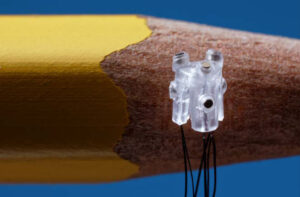
The Nighthawk demonstrator, a smart surfaces collaboration between TactoTek and Covestro, is a slim, multilayer structure with contoured surface and in-mold structural electronics. Courtesy of Covestro
Achieving an external defect rate of 10 ppm depended on several critical factors, Tremonti says:
- Working with the customer to assure that the parts are optimized for manufacturability.
- Building high-quality tools that last.
- Regular maintenance of tools, injection machines and auxiliary equipment.
- Refurbishing tools when they show signs of wear.
- Using only certified materials that are appropriate for each application.
- Assuring that processing of the material is consistent and repeatable.
- Developing quality systems that identify defective parts and assure that only defect-free parts reach the customer.
- Building and maintaining a culture of quality.
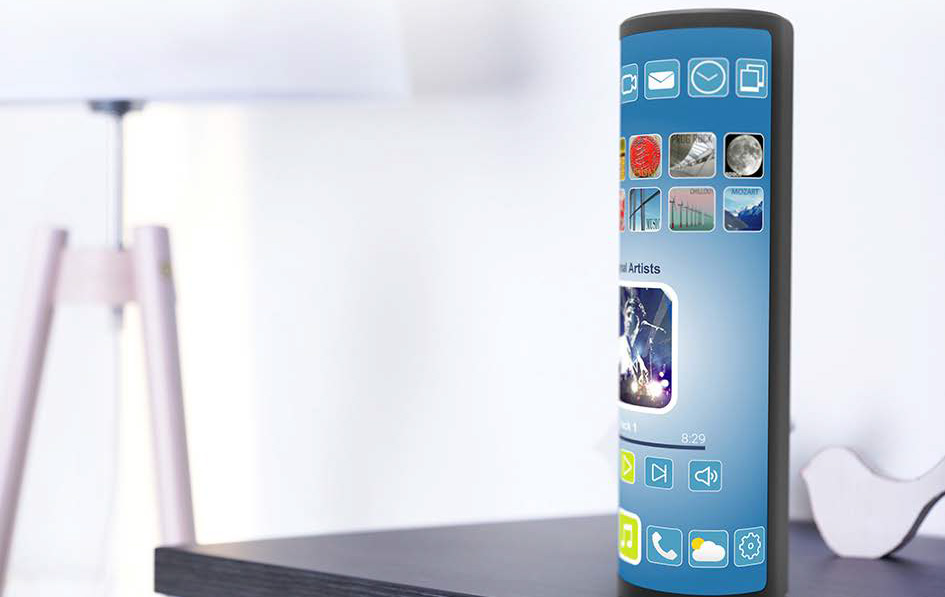
A concept image of an OLCD smart speaker with wraparound display using FlexEnable technology. Courtesy of FlexEnable
“D&M puts the time, effort and energy into understanding the characteristics of the materials that are specified—no matter how exotic or seemingly incompatible—and identifying ways to mold them that others find challenging,” Owen remarks. “Utilizing all-electric injection molding machines allows us to mold thinner-wall sections for faster, more efficient filling of each part. We develop our own end-of-arm tooling to assist in demolding difficult parts and materials [and have] developed secondary equipment to assemble, label and/or pad print parts, reducing labor costs and eliminating defects and ergonomic issues that might arise if done manually.”
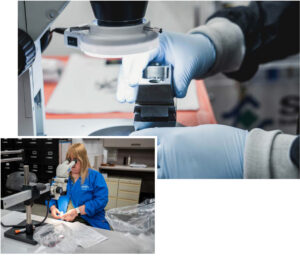
D&M Plastics specializes in tight-tolerance, high-cavitation parts with complex geometries for demanding industries like electronics. Courtesy of D&M Plastics
When electronics parts get down to the micron scale, overmolding plastic over plastic or plastic over a preformed part becomes an even more sensitive operation.
“What started as common requests like needing to overmold a substrate, such as the end of a catheter, with a simple geometry has evolved into more complex requests,” says Lindsay Mann, director of sales and marketing for MTD Micro Molding. “Problems like high fall-out rates due to adhesive issues or high costs associated with gluing or assembling post-molding became more common—and overmolding was an excellent solution that ended up reducing costs. Lately, we are receiving requests for overmolding or encapsulating delicate substrates like electronics, sensors or PCBs. We did extensive testing with this to ensure overmolding was a viable manufacturing option for these products and did not damage the substrate.”
There are two main considerations with overmolding a delicate substrate, says Patrick Haney, R&D engineer. “A big proponent of what makes overmolding substrates doable in the first place is the nature of fountain flow—that is, the way that non-Newtonian fluids flow through a channel and across a substrate. Fountain flow is a product of laminar flow, and as the different layers of plastic are laid across a substrate, it doesn’t apply awkward pressure as much as you might think,” he remarks. “The layers roll across the substrate rather than apply direct pressure onto the substrate. Once you understand that flow characteristic, then you can incorporate mold design techniques to properly support the substrate during molding.”
In terms of temperature, he continues, “When substrates degrade due to high-temperature exposure, there are two things that the degradation is attributed to: the actual temperature and the duration the substrate is exposed to that temperature. In micromolding, we have a unique advantage because our parts are so small that the melt is surrounded by a lot of relative tool steel. That mold steel acts as a rapid heat sink that removes heat from the plastic quickly—especially so in micromolding, which means the exposure time of heat to a substrate is low, measured in fractions of a second.”
Although plastic pressure rolls across the part in overmolding as opposed to hitting it directly, he cautioned, “it is still applying force to the substrate. If you have a tiny substrate you want to encapsulate and want the substrate to be exactly centered, that will be challenging without proper planning. The substrate will want to migrate in the direction of the force that is being applied. In the design phase, consider ways to support the substrate in the cavity to prevent migration once the force is applied during overmolding.”
Form-Fitting Function
As pioneers of flexible electronics that can be contoured to an array of novel shapes, FlexEnable pushes the bounds of electronics products with its thin, lightweight and shatterproof conformable OLCDs.
“Organic LCD displays are liquid crystal displays built on bioplastic films instead of glass, made possible by using organic transistors instead of silicon,” explains FlexEnable Strategy Director Paul Cain. “Manufacturable in existing display factories using a low-temperature process, the resulting OLCDs are extremely thin and light and can be wrapped around surfaces, unlocking a new dimension of freedom in product design as well as completely new use cases for smart surfaces.”
The liquid crystal cell—the pixelated optical switch built onto a bioplastic film—is flexible when it first comes off the production line, Cain says. “This flexibility facilitates how the module is assembled onto curved surfaces. The liquid crystal cell itself—the layer of pixels—can be laminated onto a curved surface such as a cover window using an optically clear adhesive, allowing the display to be wrapped around a uniaxial bend such as a cylinder or a cone. Recently, we have also shown that, due to the unique properties of the flexible liquid crystal cells and substrate materials that OLCD can use, the cell can be thermoformed into not only a uniaxial but also a biaxial curvature, allowing the display to follow complex curves such as a spherical cap.”
Molded smart speakers are a great example, he adds. “This product category can be broadly put into two types: those without and those with a display. Those that don’t contain a display are curved, usually cylindrical, and those that do contain a display are planar and resemble a tablet. Wraparound cylindrical OLCDs therefore circumnavigate this constraint, allowing cylindrical speakers to also contain a large display area. This not only allows a beautiful new product design but brings completely new use cases for the product.”
FlexEnable’s technology, which earned the 2021 Disruptive Innovation Award at the TechWorks Awards, opens dramatic vistas for product design. For instance, “There are many applications where large-area flexible displays that can be wrapped around surfaces are needed for smart home devices, including cylindrical wraparound displays for smart speakers, curved and shaped displays in kitchen appliances and white goods that follow the flowing contours of the surface. Almost any surface can be activated in this way. OLCDs are just a few hundred microns thick, meaning an OLCD can be more seamlessly integrated into surfaces, whether flat or curved—for example, for smart thermostats.”
Ultimately, Cain asserts, “Almost any surface can be activated with flexible organic LCDs, and there are many applications where curved surfaces can now accommodate displays. Our partners include many of the leading consumer electronics brands globally. Expect to start seeing products incorporating OLCD in the next 12 to 18 months.
“It’s worth adding that we are only seeing the beginning of how flexible displays will ultimately transform product design, particularly in smart home environments,” he observes. “Indeed, the constraints of current glass displays are so ingrained in our thinking that it’s easy to forget how much they limit product design. I expect that the newfound design freedom of OLCD will lead to many exciting product designs unimaginable until now.”
